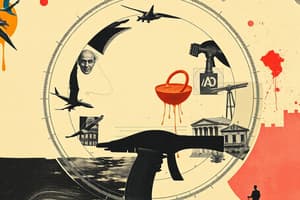Podcast
Questions and Answers
What is the primary factor that enables the circular flow model to function?
What is the primary factor that enables the circular flow model to function?
- The import and export of goods and services
- The interaction between market regulations and taxes
- The presence of government subsidies
- The continuous flow of income and expenditure (correct)
In the circular flow model, who receives monetary payment for factors of production?
In the circular flow model, who receives monetary payment for factors of production?
- Producers
- The government
- Consumers
- Households (correct)
What do payments from consumers to firms represent in the circular flow model?
What do payments from consumers to firms represent in the circular flow model?
- Monetary payments for goods and services (correct)
- Goods and services flow
- Income flow
- Resources exchanged for taxes
Which participants are considered the three basic elements of the economy in the circular flow model?
Which participants are considered the three basic elements of the economy in the circular flow model?
How does the circular flow model visually represent the economy's functions?
How does the circular flow model visually represent the economy's functions?
Flashcards
Circular Flow Model
Circular Flow Model
A model that shows how money and goods/services flow continuously through an economy.
Transaction Principle
Transaction Principle
In every economic exchange, the seller's income equals the buyer's spending.
Money Flow
Money Flow
The movement of money between firms and households for goods/services and factors of production.
Economic Participants
Economic Participants
Signup and view all the flashcards
Market Mechanisms
Market Mechanisms
Signup and view all the flashcards
Study Notes
Circular Flow Model
- Millions of South Africans participate in daily economic activities (working, buying, selling, etc.)
- The circular flow model simplifies these activities
- The model depicts a continuous flow of income and expenditure in production
- The model is continuous (no beginning or end)
Principles of the Circular Flow
- Principle 1: Sellers/producers receive the same income as consumers spend.
- Principle 2: Circular flow is driven by monetary payments. Goods and services flow oppositely
Money Flow
- Basis of the circular flow system
- Firms receive money from households for goods/services
- Households receive money from firms for factors of production (labor, land, capital)
Government's Role
- Provides payments to consumers/businesses for goods and services
- Collects taxes and resources from consumers
- Important part of the economy (consumers, producers, and government)
Market Mechanisms
- Buying and selling bring together all economic stakeholders
- Consumers and producers interact in markets; this movement of goods, services, and money is shown in the circular flow model
Studying That Suits You
Use AI to generate personalized quizzes and flashcards to suit your learning preferences.




